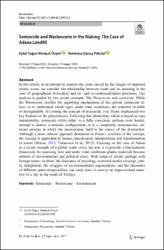| dc.contributor.author | Alnıaçık Özyer, Eylül Tuğçe | |
| dc.contributor.author | Çavuş Peksöz, Rumeysa | |
| dc.date.accessioned | 2024-04-04T14:52:05Z | |
| dc.date.available | 2024-04-04T14:52:05Z | |
| dc.date.issued | 2023 | en_US |
| dc.identifier.citation | Alnıaçık Özyer, Eylül T., Çavuş Peksöz, R. (2023). Semiocide and wasteocene in the making: The case of Adana landfill. Biosemiotics. Springer. | en_US |
| dc.identifier.uri | https://hdl.handle.net/20.500.12846/1009 | |
| dc.description.abstract | In this article, in an attempt to analyze the crisis caused by the images of imported
plastic waste, we consider the relationship between waste and its meaning in the
case of geographical dislocation and de- and re-contextualization processes. Our
analysis is guided by two recent concepts: The Wasteocene and semiocide. While
the Wasteocene clarifies the signifying mechanisms of this period, semiocide allows us to understand which signs, under what conditions, are rendered invisible
or disregardable. In coining the concept of semiocide, Ivar Puura emphasized two
key features of the phenomenon. Following this distinction, which is based on (un)
intentionality, semiocide refers either to a fully conscious, perhaps even hostile,
attempt to destroy a semiotic configuration, or to a completely nonconscious, unaware process in which the unawareness itself is the source of the destruction.
Although a more cultural approach dominates in Puura’s assertion of the concept,
the concept is applicable to human classification, interpretation and transformation
of nature (Maran, 2013; Tønnessen et al., 2015). Focusing on the case of Adana
as a recent example of a global waste crisis, our aim is to provide a (bio)semiotic
framework for assessing how and under what conditions plastic materials become
arbiters of environmental and political crises. With heaps of plastic garbage with
foreign names on them, the discourse of recycling, restricted media coverage, public indignation, the struggles of environmentalist organizations, and the encounter
of different spatio-temporalities, our study aims to convey an impoverished narrative of a city in the south of Türkiye. | en_US |
| dc.language.iso | eng | en_US |
| dc.publisher | Springer | en_US |
| dc.rights | info:eu-repo/semantics/openAccess | en_US |
| dc.subject | Semiocide | en_US |
| dc.subject | Wasteocene | en_US |
| dc.subject | Environment | en_US |
| dc.title | Semiocide and wasteocene in the making: The case of Adana landfill | en_US |
| dc.type | article | en_US |
| dc.relation.journal | Biosemiotics | en_US |
| dc.relation.publicationcategory | Makale - Uluslararası Hakemli Dergi - Kurum Öğretim Elemanı | en_US |
| dc.contributor.department | TAÜ, Kültür ve Sosyal Bilimler Fakültesi, Sosyoloji Bölümü | en_US |

















